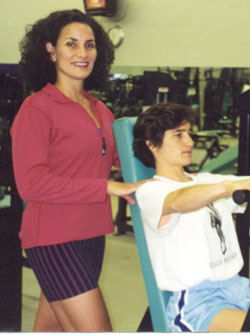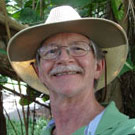Guest Fitness Expert: Interview With Roberta Lenard
Roberta Lenard -- noted fitness trainer

Roberta Lenard recently took time from her busy schedule for an interview with Dan Curtis, M.D.
She has a master's degree in exercise physiology and is a National Academy of Sports Medicine Master Trainer.
She is a former world-class rower and uses her education and extensive personal experience in her training programs.
She has been recognized as one of the top trainers in America.
She is president of Lenard Fitness and Associates.
The Interview
Dr. Dan:
Roberta, you graduated from Springfield College with a master's degree in exercise physiology. Exercise physiology is an intense area of scientific research. Is exercise physiology relevant just to the laboratory, or can the principles be used to help someone who wants to improve their overall health and physical condition?
Roberta Lenard:
The principles of exercise science are definitely relevant to someone who wants to improve their health or physical condition. Basically this course of study measures the impact of exercise on the various systems of the body, such as an increase in heart rate, blood pressure, oxygen uptake, etc.
It allows us, as health care professionals, to find out where someone is starting from and create a program that is appropriate for their needs and goals.
When putting together a program, we can look at three key areas to produce a training response from regular physical activity: duration (how long), intensity (how hard) and frequency (how often).
By manipulating these areas, we can help each individual come up with a program that they can stick with and that helps them achieve better health and conditioning.
My philosophy, similar to that of meditation leader Pema Chodron is "start where you are". The hardest part is taking that first step, but anyone who is on the path to better health and well-being knows that it quickly becomes a wonderfully addictive habit!
Dr. Dan:
Your area of expertise is in joint longevity. We tend to think of joints wearing out naturally over time. Are there certain joints that are most susceptible to injury or to wear, and that cause the most trouble for people?
Roberta Lenard:
My focus is on "joint longevity" since even the most motivated person will be on the sidelines if the joint structures break down. I see joint health as being the centerpiece of any goal: weight loss, peak sports performance or rehabilitation and general fitness.
If you're injured or in pain, you just can't play! Certainly, the more time we spend on this planet, the more "wear" our joints will experience, but how this wear is occurring can make all the difference. We try and get the wear to happen over the greatest possible surface area.
I tend to see a lot of knee issues, especially arthritis, since the knee is a reactive joint that takes the brunt of what's going wrong above (hips, back) and below (ankles, feet). Of course, among the general population there seems to be an epidemic of back pain, due to lack of exercise, weak postural muscles, too much sitting and lack of body awareness.
I urge people who have to sit a lot and who slouch to stand up and lengthen into full extension several times a day. Also, squeezing your shoulder blades together and rolling your shoulders up, back, down and forward can keep your posture, upper and lower back, in better shape without too much extra effort.
Dr. Dan:
What are some of the things that the average person should do to protect their joints from premature wear?
Roberta Lenard:
We can protect our joints in a number of ways. The first is how I start all of our clients that come in for personal training: Muscle Activation Technique, or MAT (www.muscleactivation.com). Developed by Greg Roskopf, a consultant to the Denver Broncos and the Utah Jazz, this is a procedure that allows me to identify and correct muscle imbalances that can lead to tightness, pain or injury.
It's sort of like an all-wheel alignment; would you put a lot of miles on your car if you knew it was out of alignment? Why do so to your body?
Anyway, this is a great starting point, since it gives me more knowledge of what I need to strengthen in each individual. Once they are in better alignment and the joints are more symmetrical, it makes sense to start to load the body very slowly with activity.
I also am careful to vary the use of exercise tools and change things up regularly, not only to avoid joint wear, but also to stimulate the many fiber directions and divisions of muscles that we have.
Dr. Dan:
Are there things that you've seen people do that are harmful for their joints, either in daily life or while exercising?
Roberta Lenard:
When it comes to things that can be harmful to the joints in daily life or in the gym, anything can potentially be harmful if the body cannot tolerate it: if someone lacks the necessary brain-muscle connections, jogging, swinging a golf club, even walking up and down stairs can lead to compensation patterns (using other muscles to do the job of the ones that aren't participating), and eventually the whole system breaks down.
People also need to learn the function of muscles and their end ranges of motion. Doing more range is not always better.
I see people doing dumbbell chest exercises and bringing the weights way too low, often leading to shoulder problems. The shoulder has so much mobility, naturally, that it's critical to be very careful when loading it up with weights.
Dr. Dan:
The modern diet is heavily biased toward refined foods which may be lacking important nutrients. Do these foods have any effect on joint nutrition and joint development?
Roberta Lenard:
Refined foods that are so common today not only lack the necessary nutrients for energy and muscle growth, they can also cause inflammation of the joints!
Many people have a sensitivity to wheat, refined white flour, yeast, and dairy. Add lots of sugar to that and you have a cycle of bad stuff in your gut that is getting fed by more bad stuff you put in your mouth!
Dr. Dan:
What about the supplements you see advertised for joint health? Do they work, and are they worth the money?
Roberta Lenard:
I've heard from some that the joint supplements can be helpful (glucosamine, chondroitin, etc.), but I would tend to recommend that people try to get more healthy fats and oils from food sources: cold water fish, brown rice, nuts, avocados, healthy vegetable oils, etc.
Dr. Dan:
You've been recognized as one of the top trainers in the United States by Vogue Magazine, and voted one of the top 100 trainers in the United States two years in a row by Men's Journal. And that is coming from the rarefied atmosphere of the Boston area, where there are many outstanding trainers and facilities. What can you identify in your training principles that sets you apart from the others?
Roberta Lenard:
As far as what sets me apart from other trainers, I'd have to say that I have been blessed to work in a field that I love, and I have a passion for learning, and then sharing what I've learned. Sometimes I feel like a "fitness evangelist!
I feel like I know quite a bit about a small corner of the universe, but I always integrate other aspects of life into the mixture. That keeps it more interesting for me, for my clients, and for the trainers that I teach.
Dr. Dan:
I know that your sister Catherine developed diabetes at age 2. Yet she went on to pursue dance for many years, and later joined you as vice-president of Lenard Fitness. After training at the world famous Joslin Clinic, you and Catherine developed the Dia-beat-it! fitness program. What sorts of successes have you seen in people with diabetes who have used your program?
Roberta Lenard:
My sister has done a wonderful job with the "Dia-Beat-It!" program. The greatest thing is that exercise acts like insulin…it brings your blood sugar down. Why not exercise instead of taking medication, if it's that easy?
The people who have taken part in the program have been so empowered. They have gained knowledge about how to measure their blood sugar before, during and after exercise, and what sorts of foods to take if their blood sugar gets low at any point. They have also learned how to exercise safely and at their own pace.
Dr. Dan:
You have a select group of trainers at Lenard Fitness that share your philosophy and training principles. What are the key principles that guide you?
Roberta Lenard:
I am blessed to have the privilege of working with some of the best trainers in Boston. I provide an initial, intensive training program then an apprenticeship period.
Each trainer gets to learn and practice our principles on their own, then they shadow our senior trainers and observe, and finally they work with clients under supervision. All of us get together regularly for continuing education, since even the most experienced trainer always has more to learn.
The principles we follow have to do with first establishing an in-depth understanding of the muscles, where they attach, which direction the fibers run, and what the function of each muscle is. Then we investigate the various resistance tools (body weight, free weights, barbells, dumbbells, cables, tubing, machines, cams, pulleys, etc.) and how each muscle is impacted by the differences in resistance provided by these tools.
We study the forces produced by each joint to determine if an exercise if safe or not for that joint. This knowledge allows us to have a point of reference for evaluating any exercise.
Dr. Dan:
In your view, is exercise something that we should just "suffer through" in order to get into better physical condition, or is it more than that?
Roberta Lenard:
Most of the clients that I've had over the years have come to me because they want to get healthier without hurting themselves. Many of them have become long-term clients due to the fact that they achieve their initial goals and continually create new ones.
They feel empowered, their self-esteem improves and they become transformed in their lives, overall. Also, I think they appreciate the relationship that develops with their trainer, which is a very positive experience for both parties.
Dr. Dan
I was working one time with an attorney who was helping to edit a manuscript I was preparing, and I was discussing the benefits of getting into shape. Her response was, "People don't want to get into better shape. They just want to be thin." Have you found that to be true in your experience?
Roberta Lenard:
Being thin has its advantages, but I find there are many more important reasons to exercise.
Dr. Dan:
Your training and experience helps you guide your clients to improved physical well-being. But emotional well-being is also important to you. Do you believe that physical and emotional well-being are related?
Roberta Lenard:
Are physical and emotional well-being related? Let me just answer that with a little story: a friend of mine took her godson to gymnastics class for the first time. He was about 8 or 9.
After an hour of tumbling, jumping, twirling and bouncing, he went running over to her, cheeks red, breathing hard, huge smile on his face and said, "I'm pumped!!".
My own personal experience is that exercise puts us into a heightened state: for me and many others, we see the world in a brighter light, think more clearly, make better decisions, feel more optimistic, shall I go on?
I have been an athlete all my life, and getting into my workout clothes I feel like Superman coming out of the phone booth!! I would like everyone to have that experience.
Dr. Dan:
You know what a problem obesity has become in our world. Yet many people are still "dieting" over and over, and continue to look for the easy solution to weight loss. Do you have any advice for someone who continues to struggle with their weight?
Roberta Lenard:
When it comes to struggling with weight, obviously it's important to eat healthfully and get regular physical activity. I also find that support and accountability are crucial to sticking with any lifestyle changes. Hiring a trainer or making a schedule with a friend to exercise, then factoring in convenience and consistency.
And making small, manageable changes at a pace that feels comfortable. Years ago, one of my trainers had a very overweight client who was uncomfortable with coming to the gym.
The trainer told her to pick a day and just simply drive past the gym. The next day, she would come inside but not do anything. By the third day, she was ready to start her program.
As far as eating, being prepared ahead of time makes a world of difference. Organizing meals in advance, eating in and bringing your own food saves gazillions of calories, and eating regular meals and snacks.
Dr. Dan:
Roberta, thank you so much for this valuable information.
Popular articles:
With weight loss, knowledge is power...
If you know these few truths on this page -- and if you apply them consistently in your life...
If you can't stay on it forever and be fit and healthy and strong -- then it's an extreme diet.
Here's the easy way to ruin any slightest chance you have of losing weight...
Can you eat in restaurants and still respect yourself in the morning?
Calorie density is the difference between vegetable soup and a bagel.
Hidden calories that ruin your waistline...
Will it really help to drink water to lose weight?

